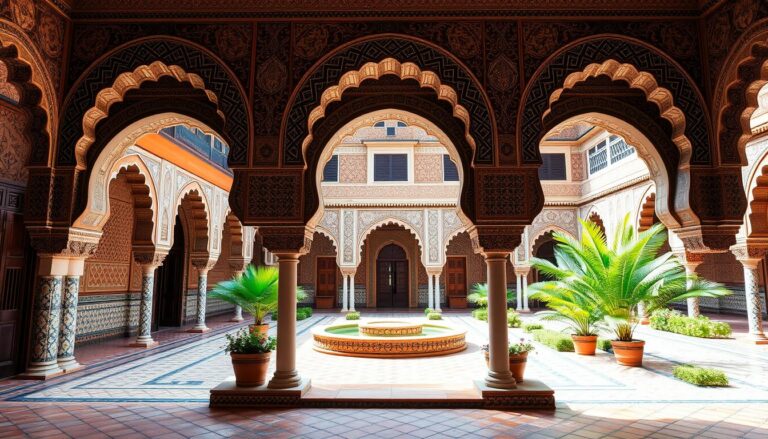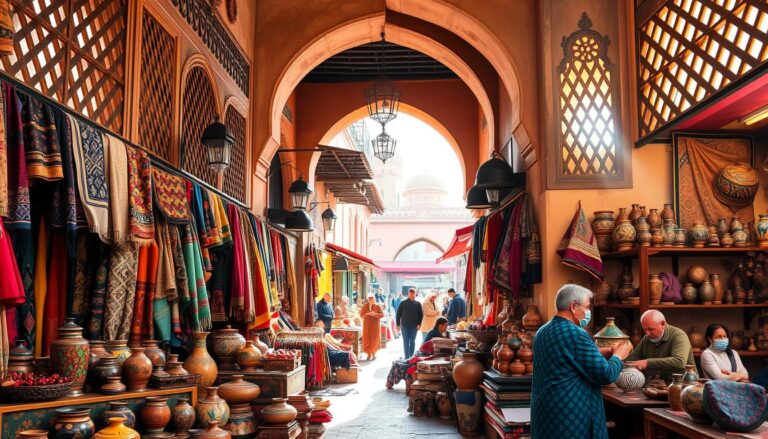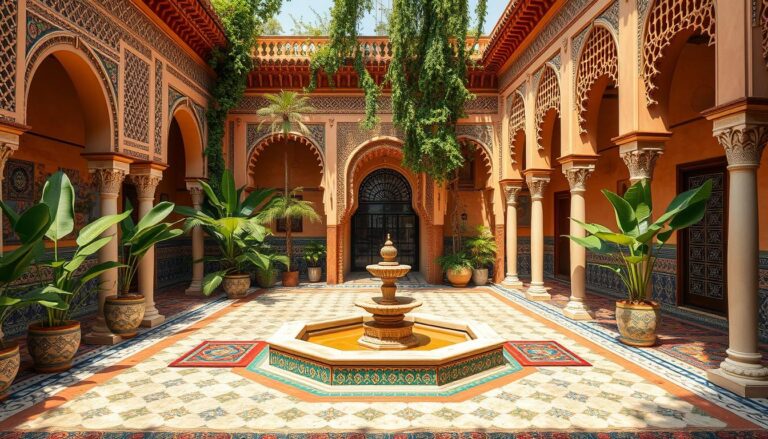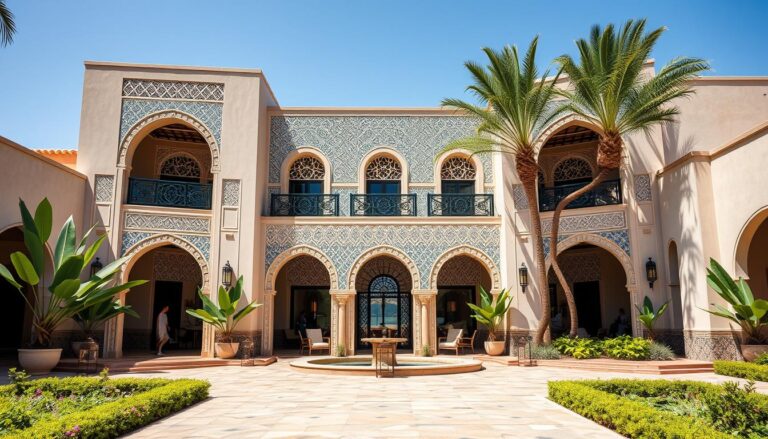In Morocco, the muezzin’s call resonates through streets, blending architecture and sound. This mix creates a deep religious experience. Moroccan mosques show how faith, architecture, and sound work together. Let’s uncover the secrets behind these spaces and how they achieve perfect sound for worship.
Key Takeaways
- Discover the evolution of Moroccan mosque design and its impact on acoustic considerations.
- Understand the symbolic elements that influence the acoustic properties of these sacred spaces.
- Explore the importance of acoustics in religious buildings and the traditional strategies employed in Moroccan mosques.
- Delve into the contemporary approaches to mosque acoustics, balancing tradition and innovation.
- Gain insights into the acoustic assessment and simulation analysis of Moroccan mosques through a case study.
Introduction to Moroccan Mosque Architecture
Moroccan mosque architecture is rich and fascinating. It has evolved over centuries. The first mosque, built by Prophet Muhammad, was simple. But, as cultures mixed, Moroccan mosques gained unique features and symbols.
Evolution of Mosque Design
Moroccan mosques have changed a lot. They started simple and now are ornate. This change shows the blend of cultures and artistic flair.
Symbolic Elements in Moroccan Mosques
Moroccan mosques stand out because of their symbols. The minaret and dome are key. They show the Islamic faith’s presence and values. These designs, shaped by history and culture, make Moroccan mosques special.
The Hassan II Mosque in Casablanca is a prime example. It can hold 25,000 inside and 80,000 in the courtyard. Its 600-foot minaret was the tallest until 2019. This highlights the mosque’s grandeur and importance.
“Moroccan mosques integrate traditional Moroccan craftsmanship with modern design elements, creating a blend of cultural richness and innovation.”
The symbols in Moroccan mosques tell a story. From mosaics to wooden carvings, they show the area’s culture and faith. These symbols attract visitors and show the lasting impact of Moroccan mosque architecture.
Acoustic Principles in Mosque Design
The role of acoustics in mosques is vital. It ensures sound quality and clarity for worship. Designers focus on speech clarity, noise reduction, and how sound lingers in the air.
Importance of Acoustics in Religious Buildings
Mosques are sacred places for prayer and community. It’s crucial to hear the Imam’s words clearly. Bad acoustics can cause echoes and distortions, ruining the worship experience.
Traditional Acoustic Strategies
Moroccan mosques use special designs to improve sound. Materials, shapes, and decorations help with sound absorption and distribution. This creates a better sound environment for prayer.
- Sound absorption techniques: Carpets and textiles absorb sound, reducing echoes.
- Reverberation control: The hall’s shape and domes help control sound echoes, ensuring clear speech.
- Architectural acoustics: Designs in Moroccan mosques enhance the sound quality, adding beauty and function.
These traditional methods help Moroccan mosques create peaceful soundscapes. They support spiritual connection and tranquility during worship.
Moroccan Acoustic design in mosques
Moroccan mosques are famous for their amazing sound design. They mix old techniques with new ones. This way, they make spaces for prayer and community that keep their cultural heritage alive.
The design of these mosques is key to their sound. The tall minaret, for example, is not just a landmark. It also helps spread the muezzin’s call to prayer far and wide. The open courtyards help sound travel, bringing everyone together.
Architects use materials like plaster, stone, and wood to improve sound. These materials, along with beautiful patterns and carvings, make the mosques look stunning. They also make the sound inside better.
“The acoustics of Moroccan mosques are a testament to the ingenuity and cultural heritage of the region. They seamlessly blend function and form, creating spaces that are both spiritually uplifting and acoustically superior.”
Today, architects are finding new ways to keep the mosques’ sound quality high. They use old and new methods together. This makes the mosques great for today’s and tomorrow’s worshippers.
Contemporary Approaches to Mosque Acoustics
As Moroccan mosque architecture grows, architects and engineers are finding new ways to tackle sound issues. They use modern building methods, like prefabrication, to improve sound quality. This keeps the mosques’ traditional look and feel.
Modern Construction Techniques
New building methods allow for better sound in Moroccan mosques. Architects use advanced materials and tools to make these spaces sound better. They place sound-absorbing materials and use modern ventilation systems to improve the sound.
Balancing Tradition and Innovation
Keeping Moroccan architectural heritage is key when adding new sound solutions. Architects aim to honor traditional mosque designs while using the latest sound technology. They blend modern materials and techniques to improve sound quality without losing the traditional feel.
The article shows how Moroccan architects and designers use new construction and sound engineering to create innovative solutions. This way, they keep the Moroccan architectural heritage alive while meeting the needs of today’s worshippers. It makes the sound experience in these sacred spaces better.
Case Study: Ben Youssef Madrasa in Marrakech
The Ben Youssef Madrasa is in the heart of Marrakech, Morocco. It’s a great example of how sound design fits into old buildings. This Islamic school is known for its amazing sound environments.
Architectural Conformation Reading
The madrasa’s design is all about sound. Its layout and materials work together to create perfect sound spaces. This careful planning shows how Moroccan builders thought about sound in old religious buildings.
Computer Simulation Analysis
Researchers used computer simulations to study the madrasa’s sound. They looked at how sound spreads and how it feels in the building. This helped them understand the madrasa’s sound design better.
“The Ben Youssef Madrasa stands as a testament to the ingenuity of Moroccan architects, who seamlessly blended acoustic design principles with the rich cultural heritage of the region.”
Acoustic Assessment in Mosques
Ensuring the best sound in mosques is key for a deep worship experience. Detailed acoustic assessments help check sound quality and find ways to improve. They balance old architecture with new sound ideas.
Assessments in mosques look at things like how sound lasts and how well you can hear. They check sound levels and how materials absorb sound. These details help make the sound better.
- Reverberation time: This measures how long it takes for sound to fade by 60 decibels. It’s important for clear speech and good sound mixing.
- Speech intelligibility: It’s crucial that everyone can hear well during prayers. Tests like the Speech Transmission Index help check this.
- Sound pressure levels: These tests find out if sound is too loud or too quiet in different places. This ensures everyone hears well.
- Sound absorption coefficients: These tests see how well materials soak up sound. This helps reduce echoes and improve sound quality.
By doing these detailed tests, architects and designers can make mosques sound better. They mix old and new ideas to create a great atmosphere for worship. This way, everyone can enjoy the spiritual and communal feel of the mosque.
“Acoustic design in mosques is not just about achieving optimal sound quality, but also about preserving the cultural and spiritual essence of these sacred spaces.”
Conclusion
This article has explored the rich tapestry of Moroccan acoustic design in mosques. It highlights the importance of keeping cultural heritage and architectural traditions alive. At the same time, it shows how to blend them with modern acoustic solutions.
It looked at different mosque styles, from old to new. This gave us a full picture of how mosque design has changed over time.
The role of acoustics in mosques was also discussed. It talked about how Moroccan mosques use sound to create sacred spaces. These spaces make the spiritual experience of worshippers better.
The article also showed new ways to mix tradition and modernity. For example, the Bedirye Tiryaki Mencik Mosque uses new technology to stay true to its roots.
In conclusion, Moroccan acoustic design in mosques is very important. We need to keep researching and innovating in this area. This will help preserve these special buildings for future generations.
By combining old and new, Moroccan mosque architecture continues to amaze and inspire. It shows the power of acoustic design in enhancing religious devotion.
Source Links
- From the rooftop of our Moroccan home…The Islamic Call to Prayer…A video… – WorldWideWaftage
- Good sound concepts for mosques?
- Sound Atmospheres of Ben Youssef Madrasa in Marrakech (Morocco)
- Hassan II Mosque: A True Marvel of Moroccan Architecture
- A Design Enthusiast’s Guide to Morocco
- Hassan II Mosque
- Mosque Architecture and Design | Islamic Art and Architecture Class Notes | Fiveable
- Acoustical Properties of Contemporary Mosques
- Al Fozan
- The mosque that powers a village
- Morocco: Beauty Around Every Corner | Catherine Jordan Design
- The Ultimate Guide to Islamic Architecture | History, Key Features, and Modern Design
- Mosques of Madinah
- Islamic Tile History and Inspiration – Why Tile
- Within the Walls of Imperial Cities – ARCHAEOTRAVEL.eu
- Post Energy Audit of Two Mosques as a Case Study of Intermittent Occupancy Buildings: Toward more Sustainable Mosques
- Mosque Typo-Morphological Classification for Pattern Recognition Using Shape Grammar Theory and Graph-Based Techniques
- Sound Techniques in Ancient Civilizations: An Analytical Study of the Geometric Shapes of Places of Worship

The Editorial Team is a passionate group of Morocco enthusiasts dedicated to sharing the beauty, culture, and wonders of this captivating country. With diverse backgrounds and a deep love for travel, we strive to bring you engaging and informative content that inspires your Moroccan adventures. From uncovering hidden gems and sharing local insights to exploring mouthwatering cuisine and showcasing the vibrant lifestyle, our team is committed to providing you with valuable resources and exciting stories that enhance your exploration of Morocco. Join us on this journey as we celebrate the rich heritage and unforgettable experiences that make Morocco truly special.







